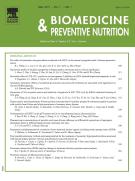Antidiabetic and antidyslipidemic nature of trigonelline, a major alkaloid of fenugreek seeds studied in high-fat-fed and low-dose streptozotocin-induced experimental diabetic rats - 23/10/14
 , Gopalan Sriram Prasath
, Gopalan Sriram PrasathAbstract |
Fenugreek (Trigonella foenum graecum) is one of the most widely used medicinal plants in folk medicine. It is known to have diuretic, cardio tonic, hypotensive, hypoglycemic and hypolipidemic effect. Trigonelline, a major alkaloid component of fenugreek, is reported to be responsible for most of its pharmacological activities. The present study was designed to investigate the effect of trigonelline on blood glucose, glycosylated hemoglobin and plasma insulin levels in high-fat-fed (HFD)/streptozotocin (STZ)-induced type 2 diabetic rats. Diabetes was induced by high-fat diet and low-dose STZ (35mg/kg.b.wt). Diabetic rats were treated with trigonelline (150mg/kg b.wt) for 30days. The toxicological as well as biochemical parameters such as blood glucose, HbA1C, insulin, insulin resistance (HOMA-IR) and lipid profile were measured. The activities of serum AST, ALT and ALP were also assayed. Trigonelline supplementation attenuated the elevated levels of glucose, glycosylated hemoglobin, AST, ALT and ALP. The insulin level was improved with an improvement in hepatic and muscle glycogen content of insulin resistant diabetic rats. Trigonelline effectively normalized the status of lipid profile. These results showed that trigonelline have potential anti-hyperglycemic and antidyslipidemic effects in HFD/STZ-induced type 2 diabetic rats.
Le texte complet de cet article est disponible en PDF.Keywords : Trigonelline, High-fat-diet, Streptozotocin, Antidiabetic, Antidyslipidemic
Plan
Vol 4 - N° 4
P. 475-480 - octobre 2014 Retour au numéroBienvenue sur EM-consulte, la référence des professionnels de santé.
L’accès au texte intégral de cet article nécessite un abonnement.
Déjà abonné à cette revue ?

